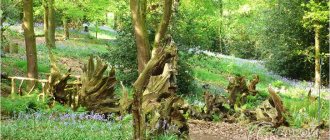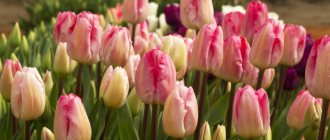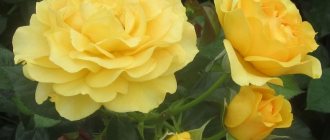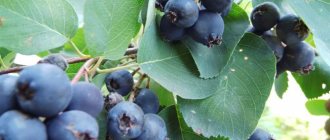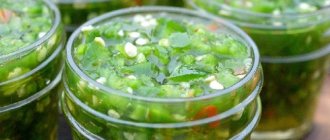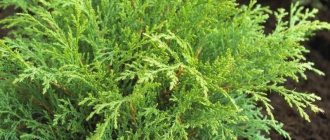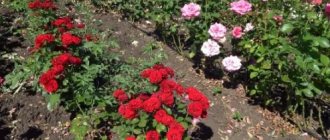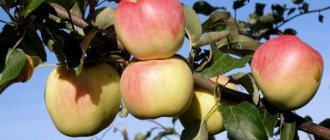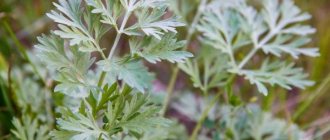Bushes and trees
0
400
Article rating
Kira Stoletova
Inversa spruce, or Picea abies inversa, is often grown to decorate garden plots. The appearance of an evergreen plant fits well into landscape design.
Spruce Inversa in landscape design
History of the variety and description of appearance
This unusual spruce arose spontaneously in nature and was discovered in 1855 by R. Smith in Shropshire (Britain).
He named the unusual tree “Inverta,” but a few years later L. Beisner corrected the involuntary grammatical error. The variety of common spruce received its slightly unusual name due to the shape of its crown. Let us remember that inversion in nature means a violation of order, when something goes contrary to the usual patterns, as if “upside down.” When you look at the Inversa tree, you immediately understand why it was called that. Short but dense branches do not grow upward, as is the case with all spruce trees, but to the sides and downwards.
The result is an unusual, “weeping” crown, which practically does not have a main trunk. From the outside, the tree resembles either a haystack, or a wide, vague figure, often as if stooped, slightly bent. The height of the “mow” can be very different - from literally one meter to 6-8. This height is usually adjusted by gardeners themselves, which will be discussed below. And the crown width is most often equal to about a quarter of the height, although in low-growing specimens these parameters may even be equal.
The color of our beauty’s needles is dark green, remaining this way even in winter. The needles are short but thick. The branches grow densely, forming a dense, slightly shiny surface. Inversa grows slowly, especially in the first few years. But even in adulthood it rarely increases by more than 20 cm per year. A significant acceleration in growth is observed after reaching 20 years of age. The shoots are initially light brown, but darken over time, sometimes even becoming reddish-brown.
Common varieties
The decorative properties of Picea Mariana Aurea are quite high, although they are inferior, albeit slightly, to Canadian spruce. This species is not so often used for landscaping garden plots, but some varieties are popular and successfully cultivated in Europe and North America:
- Black spruce Beissneri (Picea Mariana Beissneri) is a low (up to 5 m) tree of a wide-round shape (width and height are approximately the same). The needles have a silver-blue tint. The variety is slow-growing, known since 1915. Picea Mariana Beissneri is ideal for decorating large gardens. There is also a dwarf variety bred by the Dutch - Baisneri Compacta, the height of this tree does not exceed 2 m.
- Black spruce Nana (Picea Mariana Nana) is a dwarf plant whose height usually does not exceed 0.5 m. Nana means low. The crown is round and uniform. Nana's needles are delicate, very thin, and have a light green-blue color. The annual growth is insignificant, but Nana feels good in harsh weather conditions and easily tolerates frosts. Propagation of Nana black spruce is carried out by cuttings. It can be grown not only in open ground, but also used for landscaping roofs, terraces, and balconies. Nana feels great in a container; you can use it to decorate alpine slides and flower beds.
- Black spruce Kobold (Picea Mariana Kobold) is a low-growing variety, like Nana. In the 20th year of life, its height will be about 1 m, while the annual growth will not exceed 5 cm. The crown is spherical, very dense. The needles are usually dark green. This spruce comes from Germany, where it was bred in 1951. It can be successfully grown throughout the middle zone and looks good as a hedge.
- Black spruce Doumeti (Picea Mariana Doumetii) is a low (up to 6 m) tree with a wide conical crown. The branches are dense, ascending. The needles are thick, colored in a light blue tone. The peculiarity of this variety is the cones, which are located directly on the trunk. Among other varieties, Mariana Aurea is distinguished by its accelerated growth rate. The variety was bred in France around 1855, propagation is carried out exclusively by cuttings. Spruce is optimally suited for decorating parks, squares, squares. Looks great both in single and group plantings.
There are also other varieties of Picea Mariana: with variegated needles (Argenteo Variegata), weeping (Pendula), low-growing species like Nana (Ericoides, Empetroides).
Spruce care
To keep the plant healthy and beautiful, you need to water it on time. An adult Inversa spruce can withstand dry weather for 10 - 12 days. Young plants require special care. They should be watered once every 5-7 days. If the weather is dry, you need to add water more often. For 1 sq. m. you should spend 10-12 liters.
When adding water, you need to make sure that it gets into the tree trunk and not onto the needles. In order for the plant to receive moisture longer, it is necessary to mulch it. It is recommended to use one of the natural materials:
- bark;
- sawdust;
- pine needle shavings.
The optimal size of the mulch layer is 6 cm. Some gardeners sprinkle expanded clay around the spruce tree or lay beautiful pebbles. If you haven't mulched, be sure to loosen the soil to remove all weeds.
In order for coniferous crops to maintain their decorative properties, it is necessary to feed them regularly. If fertilizer is applied at planting, there will be no need to apply fertilizer for several years. I feed the spruce with a complex product for conifers. She responds positively to Epin's solution. I apply it from a spray bottle.
An adult Inverse spruce does not need to be fed, but caring for it involves pruning. During the process, dried, weakened or diseased branches are removed. Replantation is carried out, if necessary, once every 15 years. It is better to plant a spruce in a new place when the temperature is within + 10 degrees.
First you need to dig a trench 30 cm in size, its depth should be within 110 cm. Before replanting, you need to adjust the roots of the spruce. Pour humus into the bottom of the hole and add a little means to stimulate root growth. Before planting in a new place, you should also add water.
Features of care
The most difficult and responsible part is pruning and shaping the crown. The fact is that Inversa has neither a main trunk nor a central shoot. Its branches immediately begin to grow downwards, bending towards the ground. In order for the tree to rise in height, you should select one of the shoots and point it upward, regularly tying it to an artificial support.
This leader shoot will grow as long as it is given support. The remaining branches will rush to the sides and down. By pinching them regularly, you can create a crown of the desired shape. As soon as you decide that you no longer want the spruce to grow tall, stop tying up the leading shoot, and soon it will droop down, like the rest of its brothers. It turns out that the gardener can vary the height of the plant at his discretion.
For your information! Some gardeners advise cutting off the main shoot once the desired height is reached. This will immediately provide a powerful stimulus for the growth of side branches.
Speaking about pruning, it would be useful to say that the lower branches eventually fall to the ground. There they are poorly ventilated, damp, and can eventually “catch” various fungal diseases. To prevent this from happening, you need to cut them off too, not allowing them to touch the ground.
This spruce is undemanding to soils, although you should still pay attention to ensure that they do not become swampy or saline. Loves plenty of light, but grows well in partial shade. It demonstrates excellent frost resistance, always gratefully responds to timely watering, but also tolerates drought.
Reviews
Judging by the reviews, gardeners are completely satisfied with the Inverse Christmas tree: it takes root well, is not afraid of frost, and tolerates heat adequately. Growth can be adjusted at will by choosing the desired grafting height and forming the crown.
The tree does not take up much space, but adds an original touch to the garden design. As a tapeworm, it is great for small areas.
It has been noticed that this conifer loves well-lit or slightly shaded places. It also grows normally in the shade, but it is not as lush and dense.
I planted 1 copy of Inversa spruce. The seedling is not capricious and grows well. I hope it will soon turn into a beautiful spruce with drooping branches. This article provides a description of the Inverse spruce, and I also talk about the cultivation of this crop.
Purchasing a seedling and planting features
Before buying a seedling, pay attention to its root system; it must be closed. Planting material with overdried roots is not suitable for planting. If the roots are bare and in drought conditions, the plant dies within a few minutes.
I recommend buying planting material from a trusted garden center. If the seedling is healthy, its needles are bright. The roots of high-quality planting material do not protrude from the container. Spruce, ready for planting in open ground, has an earthen ball about 80 cm in size, and its diameter is 50 cm.
I advise you to plant spruce on the twentieth of April. Some summer residents practice autumn planting, which is also quite justified. If you plant a spruce closer to autumn, it will quickly take root in a new place. But it is better to plant a large variety closer to March. The earthen lump of such a plant should be frozen.
It is recommended to plant low varieties of spruce near buildings. Plants should be placed away from trees, as the latter take away nutrients. It is advisable to place the Inverse spruce in a well-lit bed.
The needles of a garden crop must receive enough sunlight, otherwise they will become less attractive. Large varieties of spruce evenly form a crown.
Boarding procedure
You need to dig a 60 cm hole under the seedling. If you plant a spruce in heavy soil, be sure to lay drainage at the bottom of the hole. It could be a broken brick. Sprinkle the drainage layer with clean sand (layer thickness within 20 cm). An ideal soil mixture for spruce includes:
- clean fertile soil;
- humus;
- sand;
- nitroammophoska.
You can add a little forest soil. Before planting a spruce, you need to treat the root system. It is recommended to soak it in water for 2.5 hours. After this, you can carefully plant the seedling.
Planting material must be installed vertically. After planting, be sure to compact it. The root collar should rise 2 cm above the ground level. Planting spruce also involves forming an earthen rampart, thanks to which water in the tree trunk circle does not spread.
After planting the plant, add 15 liters of water and mulch using peat. Be sure to keep your distance when boarding. If the spruce is large, place it at a distance of 3 m from each other.
Spruce Inversa
In our area, this evergreen tree began to gain popularity relatively recently. However, literally in one decade it won the hearts of many Russian residents. And all because the Inverse spruce has an extremely amazing crown shape. It is this that is the calling card thanks to which this tree is recognized all over the world.
True, using the word “crown” in the usual sense would be incorrect. After all, it is formed artificially by tying or grafting spruce shoots. In this case, the tree does not have a main trunk, which is why it is necessary to use a guide support or strengthen one of the many shoots.
It is noteworthy that Inversa spruce rarely grows to a height of more than 8 meters. Moreover, many trees freeze at around 6 meters. In this case, the diameter of the “crown” ranges from 2-2.5 meters. However, gardeners often decide for themselves how large their tree will grow. Fortunately, this is very easy to do; you just need to trim off the excess shoots in time. As for the needles, the spruce needles are dark green, with a very dense arrangement of needles.
Characteristics of Inversa spruce
For 5 - 6 years it does not form lateral branches. The bark of this compact coniferous plant has a rich green color and looks like thin plates. Inversa spruce has short needles. The needles are arranged like a spiral in 2 rows.
Inversa spruce is a gymnosperm plant and has oblong cylindrical cones. Coniferous seeds do not lose their viability for 7 years. Their ripening is observed in mid-autumn.
Spruce seeds are quickly dispersed by the wind. Some trees bear fruit at the age of 10 years, others at the age of 60 years. The average lifespan of spruce is 250 years. However, there are trees that are 1500 years old!
Coniferous crops do not make high demands on growing conditions; they are completely unpretentious in care. Inversa spruce has excellent decorative characteristics, which is why it is actively used in landscape design. Some gardeners prefer dwarf varieties, others prefer large ones.
Detailed description
The Inversa variety is a low-growing variety, or more precisely, growth depends on the standard to which the Christmas tree is grafted. On average, it grows to 6-8 m, gaining about 200 cm in diameter.
You can increase the height of a tree using shaping.
The crown shape is weeping, unevenly developed. The branches are lowered down, the lowest ones spread along the ground in a kind of trail.
In general, the tree resembles a tall bush or a flowing cascade. The color of the needles is juicy dark green. The needles are plump, shiny, and medium in size. The cones are light green at an early stage, but over time they become brown, reaching a length of 10 cm. The root system is superficial, well branched.
Use in landscape design
Spruce will decorate your site
Thanks to its unpretentiousness and original shape, the Inverse Christmas tree is very common in landscape design. It is often used in mixed compositions or as a solitaire. It looks great with other conifers, deciduous plants, flowers, and ornamental grasses.
The tree tolerates pruning and shaping well - its crown can be given a wide variety of shapes. This allows the Christmas tree to be used in different styles: English and Japanese gardens, rock gardens, flower beds, and near ponds. Several spruce trees make an original hedge or border with lower branches creeping along the ground.
Seedlings and tree planting
You can buy Inverse spruce at a gardening store. It is best to take those plants that are sold in pots. This is due to the fact that such a tree will have stronger roots, and they will certainly take root in the new land. In addition, you can plant a seedling at any convenient time, without worrying that it will wither from a lack of nutrients.
It is better to plant this plant in mid-spring. It is during this period that the most favorable processes for growth occur in the soil. However, if necessary, you can do this at another time. The main thing is to provide the young spruce with the right amount of moisture in the first week of its new life.
Diseases, pests
Spruce is susceptible to diseases and pests. The threat is posed by pine needle rust, which is of fungal origin. The disease manifests itself as golden blisters on the needles. The average size of such bubbles is 2.5 cm. After some time, spores emerge from them and are transmitted to other plants.
To ensure the prevention of this disease, it is necessary to apply 1% Bordeaux mixture in early June. Instead of this product, you can use another fungicide. To prevent the spruce from getting rust, you need to water it on time and remove dry leaves.
Schutte is another disease that appears in the spring, usually affecting last year's shoots. Gradually they die off. Because of this disease, the spruce lags behind in growth. Having discovered signs of schutte, it is necessary to remove the affected branches and apply a fungicide. To cure a plant, you should treat it 2 times.
Root sponge is a disease common among coniferous crops. It leads to rotting of the root system. The Root Sponge can also attack deciduous crops. The disease is manifested by rotting of the root system and damage to the base of the trunk.
It is covered with leathery brown spots, which are yellowish or white inside. If you notice signs of the disease, you need to urgently apply a fungicide. It happens that the spruce is attacked by pests. Spider mites pose a threat. They attack in dry weather and leave dark spots on the surface of the plant.
If there are a lot of pests, the needles turn yellow-white. To prevent insects, you need to spray the tree with insecticides. It is advisable to carry out treatments in dry, warm weather in the morning or evening. In the fight against spider mites, it is worth using acaricides. One of the most popular drugs is Opala.
Common spruce sawflies are yellow insects that attack young coniferous crops. Sawflies infect needles and shoots; in this case, the needles become red-brown, but do not fall off. For prevention, you need to use insecticides, and also loosen the soil in the tree trunk in a timely manner. It is very important to destroy nests where pests are located.
How to care
The tree needs to be watered regularly
Caring for Inverse spruce in artificial growing conditions consists of properly organized watering and timely application of fertilizer complexes.
Watering
Immediately after planting, the tree is watered regularly for a week, almost every day. When watering, it is necessary to avoid stagnation of moisture. During the hot season, it is necessary to moisten the spruce. The standard water consumption is 10-12 l.
Loosening and mulching
The variety does not tolerate compacted soil well, so after watering and heavy rains the soil under the spruce must be loosened. Mulching with grass helps prevent moisture evaporation, which will also act as fertilizer during the process of decay.
Feeding
Fertilizer is applied twice per season. The most suitable mineral composition will be a nutritional complex specially developed for conifers.
Trimming
Trimming a tree is often not recommended. The procedure is necessary when it forms a hedge. Old and damaged branches are usually removed. The right time for sanitary pruning is May-June, at the stage of active sap flow.
Reproduction
Propagated by cuttings and seeds:
- when cuttings, an exact copy of the original tree with maternal qualities is obtained;
- When propagated by seed, a higher quality plant is grown with increased resistance to low temperatures.
Winter protection
Despite its cold resistance, Inversa spruce is covered with spruce branches for the winter. The trunk is covered with a layer of peat up to 5 cm thick. When the season is over, the peat is mixed with the ground, but not removed.
Description Inversa common spruce (Picea abies Inversa) is a weeping form characterized by the absence of a central shoot (sometimes there are specimens with an indistinct trunk). It is often grafted onto a trunk, the height of which determines the future height, while the crown looks almost columnar, with branches tightly fitting the trunk. Tree up to 6 - 8 m tall, with a narrow, unevenly developed crown up to 2-2.5 m in diameter in old plants. Branches and shoots are hanging, falling down, vertically vertical, while the lower branches lie on the ground. The top has a falling growth pattern. The trunk is densely covered with branches. The buds are obtuse, red-brown, surrounded by two relatively large lateral buds. The needles are short, thick, dark green, shiny. Propagated by grafting - either on prickly or ordinary spruce. Common spruce Inversa is used as a tapeworm or in group plantings, in rock gardens. Photophilous, tolerates light partial shade.
| Crown diameter: | 3-5 m tall. Old specimens have a height of 6-8 m with a diameter of 2.0-2.5 m. |
| Root system: | superficial, widely spread, highly branched; deep on drained soil. |
| Growth rate: | up to 10-15 years it is low, then it accelerates to 70 cm per year, after 100-120 years growth slows down again. |
| Soils: | fresh or moist, moderately nutrient-rich, sandy-clay substrates, acidic to alkaline, generally undemanding (see What is Soil Acidity: Determining and Managing pH). |
| Watering: | During dry periods, watering is required. |
| Winter hardiness: | this variety has good winter hardiness, USDA zone 3 (see Climatic zones). |
| Fruit: | cones are 10-15 cm long and 3-4 cm thick, light green, brownish-brown when mature. |
Planting and caring for Norway spruce Inversa
Do not allow soil compaction and moisture stagnation. The planting site should be away from groundwater. It is imperative to make a drainage layer, in the form of sand or broken brick, 15-20 cm thick. If spruce trees are planted in groups, then the distance for tall spruce trees should be from 2 to 3 m. The depth of the planting hole is 50-70 cm.
It is important that the root collar is at ground level. You can prepare a special soil mixture: leaf and turf soil, peat, and sand in a ratio of 2:2:1:1. Immediately after planting, the tree must be watered generously with 40 - 50 liters of water. It is advisable to apply fertilizer (100-150 g of nitroammophosphate, 10 g of root per 10 l, etc.).
Spruce trees do not like dry, hot weather, so during the hot season they need to be watered once a week, approximately 10-12 liters per tree. Carry out shallow loosening (5cm). For the winter, sprinkle peat around the trunk with a thickness of 5-6 cm; after winter, the peat is simply mixed with the ground, not removed. Spruce trees can also be planted in winter.
Approximately 2 times a season you can apply fertilizer for coniferous plants.
Typically, spruce trees do not need pruning, but if they form a hedge, pruning is allowed. As a rule, diseased and dry branches are removed. It is best to carry out pruning in late May - early June, when the period of active sap flow ends.
To protect the decorative forms of spruce from autumn and winter frosts, they can be covered with spruce branches. (see Winter shelter for coniferous plants, Pests and diseases of spruce. Treatment).
